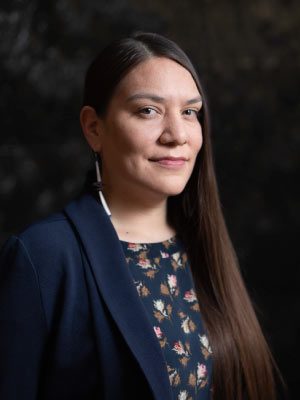
It’s not every day a working professional engineer trades their “PE” stamp for academia. But for Grace Bulltail, the two threads had always been interwoven. “My work has always been interdisciplinary,” she says, “or at least my interests have been.” After earning her bachelor’s degree in civil and environmental engineering from Stanford, Bulltail worked as a water-resources engineer for tribal communities — work she continues today. She went back to graduate school, culminating in a PhD in biological systems engineering from Cornell University. She joined the Nelson Institute in 2019 through a cluster hire focused on Native American environment, health, and community. On campus, Bulltail holds affiliations with biological systems engineering, geography, environmental studies, the Nelson Institute Center for Sustainability and the Global Environment — and she runs the Indigenous Environment and Science Working Group. Here, Bulltail discusses two of her upcoming undergraduate courses: From Field to Laboratory; Hands-On Techniques for Students in Water Sciences (ENVIR ST 401) and Environmental Justice and Indigenous Communities (ENVIR ST 600).
Tell me about your new summer course, Hands-On Techniques for Students in Water Sciences.
Students will enroll in a course on campus here, but it will be taught at UW–River Falls. We want to have students be comfortable in running field work that is relevant to water, primarily water sampling and collection analysis. I think it will help them think through what type of experiments and research they want to do, and think logistically: “If I want to study the interactions with soil and water, what type of preparation am I going to need, and how am I going to go about doing that?”
How did the collaboration with UW–River Falls come together?
The co-principal investigator on that is my colleague Bahareh Hassanpour, assistant professor of environmental science at UW–River Falls. We were in the same research lab at Cornell University: the Cornell Soil and Water Lab. [In the lab,] Bahareh taught me how to use the equipment and how to go about running the experiments. So, when she became faculty at UW–River Falls, we were looking for an opportunity that we could work on together.
You have to follow Supreme Court cases [and] think, “Well, where are the tribes involved?” They’re often left out of the discussion, but they’re an important piece of that argument.”
— Grace Bulltail
You’ve been teaching the capstone course Environmental Justice in Indigenous Communities for three years. What do you love about the course?
I always look forward to the types of topics that students are interested in. Each student group usually addresses it in a different way. The first year was during the pandemic, so it was completely online. The students really focused on the campus community, particularly what student groups were doing, and tied that into more timely discussions on the issue of land grant universities and how campuses are now trying to address the legacy of land grant, particularly acknowledging the displacement and dispossession of Indigenous peoples, like in our own state here.
What do students read?
Even within the environmental justice literature, it’s difficult to find instances of Indigenous communities, particularly here in the United States. The struggle of Indigenous communities has been brought more to the forefront, particularly after Standing Rock, but I like to find issues that are relevant to the state. One that I just covered is the Mole Lake Band of Sokaogon —there was a State Supreme Court case that did not want to recognize their authority to set their own water quality standards, which has been granted by the Environmental Protection Agency.
How do you approach the class?
I really approach it from an interdisciplinary framework, myself being an engineer. I want them to detail a challenge with environmental justice based on the topics that we cover, and then while they’re doing that, to think about possible interventions. That’s something that’s always driven me as an engineer: to think about how to address some of these challenges. What are some policy interventions? What are some community-based actions?
Why is understanding policy so important for environmental studies?
Anyone that works with tribal communities, it’s almost a given that you need to know the federal and state environmental policies. You have to follow cases that are making their way through the Supreme Court [and] think, “Well, where are the tribes involved?” They’re often left out of the discussion, but they’re an important piece of that argument. And I would say it’s just part of being an Indigenous person, and particularly with working with Indigenous people. I guess I always saw policy and interdisciplinary issues going hand-in-hand. Environmental justice has always been a part of the picture as well. The communities that I come from, that I work with, have these legacies of natural resource extraction. That is always going to be part of the history and the ongoing futures of what we need to think about when talking about our communities.